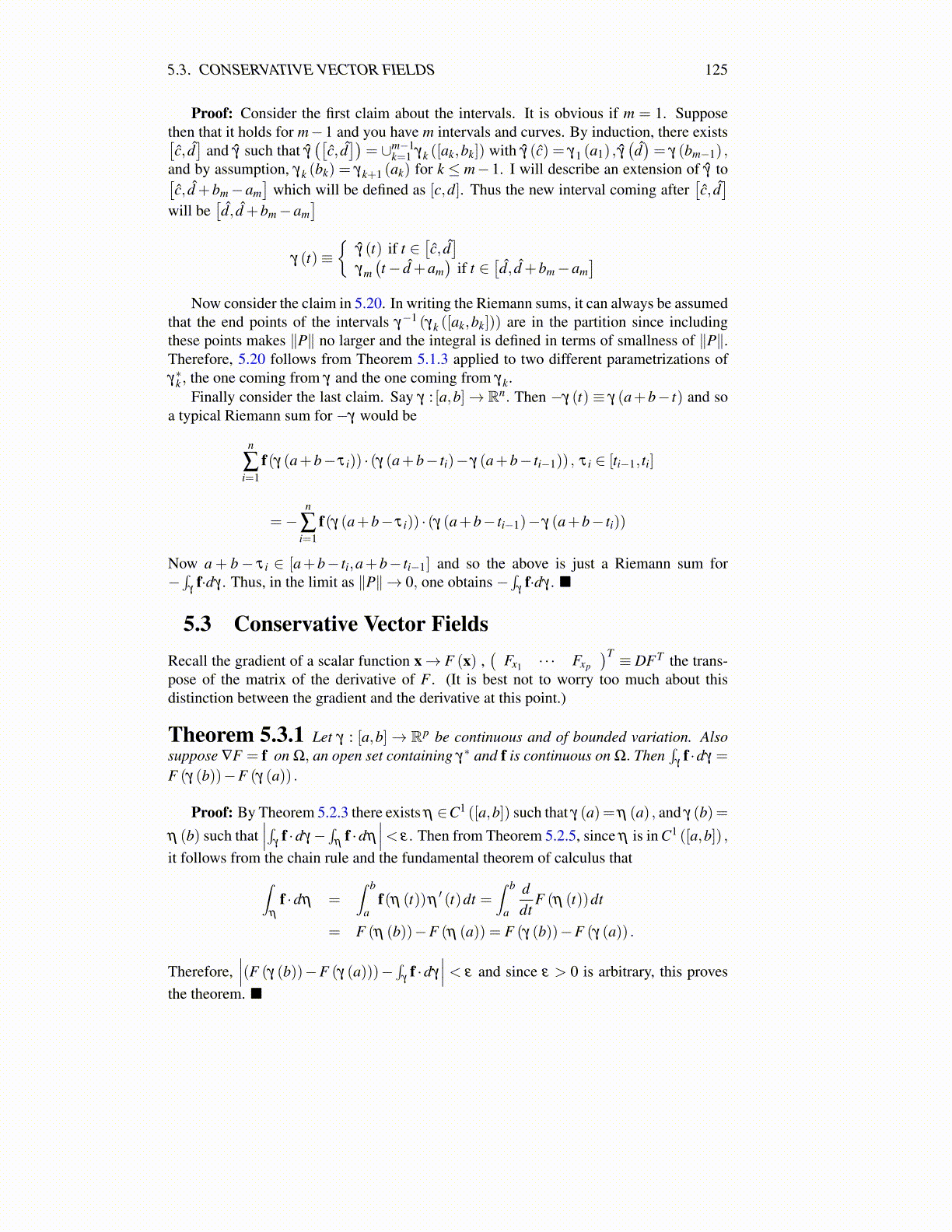
5.3. CONSERVATIVE VECTOR FIELDS 125
Proof: Consider the first claim about the intervals. It is obvious if m = 1. Supposethen that it holds for m−1 and you have m intervals and curves. By induction, there exists[ĉ, d̂]
and γ̂ such that γ̂([
ĉ, d̂])
= ∪m−1k=1 γk ([ak,bk]) with γ̂ (ĉ) = γ1 (a1) , γ̂
(d̂)= γ (bm−1) ,
and by assumption, γk (bk) = γk+1 (ak) for k ≤ m− 1. I will describe an extension of γ̂ to[ĉ, d̂ +bm−am
]which will be defined as [c,d]. Thus the new interval coming after
[ĉ, d̂]
will be[d̂, d̂ +bm−am
]γ (t)≡
{γ̂ (t) if t ∈
[ĉ, d̂]
γm(t− d̂ +am
)if t ∈
[d̂, d̂ +bm−am
]Now consider the claim in 5.20. In writing the Riemann sums, it can always be assumed
that the end points of the intervals γ−1 (γk ([ak,bk])) are in the partition since includingthese points makes ∥P∥ no larger and the integral is defined in terms of smallness of ∥P∥.Therefore, 5.20 follows from Theorem 5.1.3 applied to two different parametrizations ofγ∗k , the one coming from γ and the one coming from γk.
Finally consider the last claim. Say γ : [a,b]→ Rn. Then −γ (t) ≡ γ (a+b− t) and soa typical Riemann sum for −γ would be
n
∑i=1
f(γ (a+b− τ i)) · (γ (a+b− ti)− γ (a+b− ti−1)) , τ i ∈ [ti−1, ti]
=−n
∑i=1
f(γ (a+b− τ i)) · (γ (a+b− ti−1)− γ (a+b− ti))
Now a + b− τ i ∈ [a+b− ti,a+b− ti−1] and so the above is just a Riemann sum for−∫
γf·dγ . Thus, in the limit as ∥P∥→ 0, one obtains −
∫γ
f·dγ . ■
5.3 Conservative Vector FieldsRecall the gradient of a scalar function x→ F (x) ,
(Fx1 · · · Fxp
)T ≡ DFT the trans-pose of the matrix of the derivative of F . (It is best not to worry too much about thisdistinction between the gradient and the derivative at this point.)
Theorem 5.3.1 Let γ : [a,b]→ Rp be continuous and of bounded variation. Alsosuppose ∇F = f on Ω, an open set containing γ∗ and f is continuous on Ω. Then
∫γ
f ·dγ =
F (γ (b))−F (γ (a)) .
Proof: By Theorem 5.2.3 there exists η ∈C1 ([a,b]) such that γ (a)=η (a) , and γ (b)=
η (b) such that∣∣∣∫γ
f ·dγ−∫
ηf ·dη
∣∣∣< ε . Then from Theorem 5.2.5, since η is in C1 ([a,b]) ,it follows from the chain rule and the fundamental theorem of calculus that∫
η
f ·dη =∫ b
af(η (t))η
′ (t)dt =∫ b
a
ddt
F (η (t))dt
= F (η (b))−F (η (a)) = F (γ (b))−F (γ (a)) .
Therefore,∣∣∣(F (γ (b))−F (γ (a)))−
∫γ
f ·dγ
∣∣∣ < ε and since ε > 0 is arbitrary, this provesthe theorem. ■